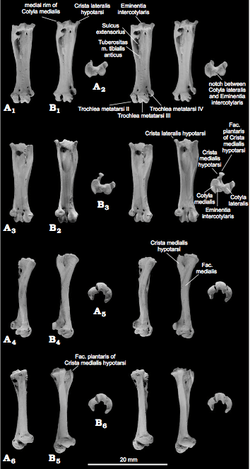Glaucidium kurochkini
| Glaucidium kurochkini Temporal range: Late Pleistocene, 0.05 Ma | |
|---|---|
 | |
| Glaucidium kurochkini holotype tarsometatarsus in multiple views | |
| Scientific classification | |
| Kingdom: | Animalia |
| Phylum: | Chordata |
| Class: | Aves |
| Order: | Strigiformes |
| Family: | Strigidae |
| Genus: | Glaucidium |
| Species: | †Glaucidium kurochkini Campbell et al., 2013 |
Glaucidium kurochkini is an extinct species of pygmy owls which existed in what is now California, U.S.A. during the late Pleistocene epoch.[1]
Discovery and naming
The holotype of Glaucidium kurochkini is LACM RLB K9630, a left tarsometatarsus. The paratypes, a left and right tarsometatarsi, LACM(CIT) 155031 and LACM(CIT) 155032, respectively. All three specimens come from the Rancho La Brea of Los Angeles, California. They all also persist to the Pit A in Bliss 29 of the area. Other possible specimens that are from the area but cannot be certainly assigned to G. kurochkini are K9631, a proximal left mandible; K9632, a complete right mandible; K9210, a complete right coracoid; G50, a complete left humerus; K9635, a proximal end of a right radius; K9404, a complete right carpometacarpus; K9350, a complete left femur; K984, a complete left tibiotarsus; and K9402, K9422, and K9423, all left tibiotasi.[1]
Etymology
G. kurochkini was named in 2013 by Campbell et al.. It was named in honour of the late Evgeny N. Kurochkin, ornithologist and paleornithologist from the Paleontological Institute of the Russian Academy of Sciences, for his leading role in Russian ornithology and his many important contributions to our understanding of avian evolution.[1]
Distinguishing anatomical features
G. kurochkini can be assigned to Glaucidium with certainty, because it shows the features distinguishing it from Aegolius, even if the two genera are almost identical. The following set of features can distinguish G. kurochkini from all other Glaucidium species: a Crista lateralis hypotarsi that is short, broad, robust, and projecting equally proximally and laterally; an Eminentia intercotylaris that is long anteroposteriorly; the presence of a Cotyla medialis with the rim, in anterior view, essentially even with side of shaft; a Facies medialis that is wide proximally and lateral to the Crista medialis hypotarsi; a Sulcus extensorius that does not extend distally to the Tuberositas medialis tibialis anticus; and a Trochlea metatarsi II with an anterior medial edge relatively straight in anterior view.[1]
See also
- Asphaltoglaux, a very similar species also known from the La Brea Tar Pits
- Oraristrix, another, much larger owl from the La Brea Tar Pits
References
- 1 2 3 4 Campbell, K.E. Jr.; Bocheński, Z.M. (2013). "Two new late Pleistocene miniature owls from Rancho La Brea, California". Acta Palaeontologica Polonica. 58 (4): 707–721. doi:10.4202/app.2011.0125.
| Quaternary | ||
|---|---|---|
| Pleistocene | Holocene | |
| Early | Middle | Late | Preboreal | Boreal | Atlantic | Subboreal | Subatlantic | |